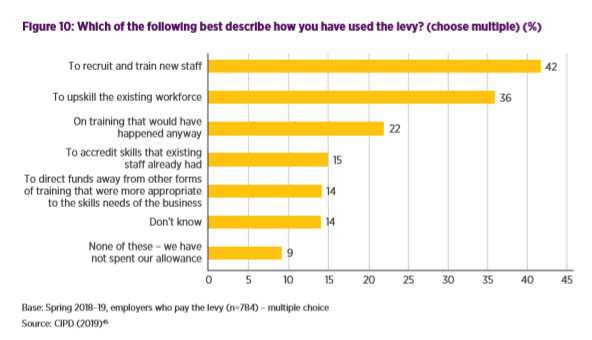Are you an apprenticeship levy payer? Do you feel that you are getting the most value out of your levy allowance?
Research from the CIPD suggests that, more than two years on from the introduction of the apprenticeship levy, a significant number of employers are not yet making the best use of their allowance, with 15% using their levy allowance to accredit existing skills, and 14% directing funds away from other, more relevant training.

[Table 1. Included with the permission of the publisher, the Chartered Institute of Personnel and Development, London (www.cipd.co.uk)]
Apprenticeships are an excellent way to grow talent from within your business, with employees that demonstrate your company’s values, understand your preferred ways of working and feel valued by the organisation.
But the pressure to spend an allowance that is expiring each month can lead to reactive decision making and the implementation of apprenticeships that are not right for the employer, or for the apprentice. Anecdotal evidence suggests that this can result in losses to productivity and lower employee morale.
So how can you get the most value out of your apprenticeship levy?
Step 1: Planning
The first step in making the most of your levy allowance is to take ownership of your apprenticeships. This means getting to understand the apprenticeship standards and undertaking a thorough review of your organisation’s skills needs, before going to the training provider.
You also need to map the workplace role against the chosen apprenticeship standards to confirm that there is a good fit.
Taking the long term view: Apprenticeships should be about filling the medium to long term skills needs of your business, so your business strategy plays a key role in apprenticeship decision making.
Will an apprenticeship add value?
Apprenticeships are one of many different development activities that your organisation can use to develop its employees, and the method of development must provide a value to the organisation. Look at apprenticeships in the wider context of workforce development and carefully consider where apprenticeships will be the best tool for the job.
Step 2: Managing
Assign an apprenticeship manager
Apprenticeships are a longer term commitment, and more complex than many other forms of training, and so they need to have the right level of focus and management support. Many organisations will rely heavily on training providers to manage their apprenticeships, but it is essential that the employer retains ownership, to ensure that apprenticeships are fulfilling the business requirements.
An apprenticeship manager will need to have a thorough understanding of
- apprenticeship standards, and
- the skills requirements within the business.
They will be responsible for managing relationships with training providers, managing the apprenticeship levy, and engaging the wider workforce with apprenticeships.
Depending on the size of your apprenticeship programme, the role of apprenticeship manager could be taken on by an existing member of staff, or developed into a new role.
On-programme support and progression planning
Give your apprentices the support they need during their apprenticeship to develop their knowledge, skills and behaviours, and to make a valuable contribution to the business. If the apprentice doesn’t have a good apprenticeship experience, then they are not going to stay with you once their apprenticeship is complete, which means that the investment that you’ve made in that individual is lost.
For the same reason, decide up front what will happen once the apprenticeship is complete, and how those learned skills can be utilised within the company.
There are still a lot of teething problems with the apprenticeship reforms, with many organisations and bodies voicing their dissatisfaction, and some organisations not spending their levy fund at all. But there are still a large number of successes that show that apprenticeships can significantly benefit your business. Correct positioning of apprenticeships as part of your overall L&D strategy, effective management and support of apprentices and a value driven progression plan for once they’ve completed will ensure that you can get the best return from the funding allocation that you have to invest.

